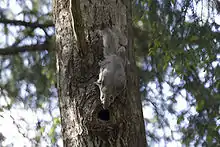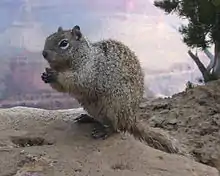Siberian flying squirrel
The Siberian flying squirrel (Pteromys volans) is an Old World flying squirrel with a range from the Baltic Sea in the west to the Pacific Coast in the east. It is the only species of flying squirrel found in Europe. It is considered vulnerable within the European Union where it is now found only in Estonia, Finland and Latvia out of the 27 countries in the Union.
| Siberian flying squirrel | |
|---|---|
 | |
| next to nesthole | |
| Scientific classification | |
| Kingdom: | Animalia |
| Phylum: | Chordata |
| Class: | Mammalia |
| Order: | Rodentia |
| Family: | Sciuridae |
| Genus: | Pteromys |
| Species: | P. volans |
| Binomial name | |
| Pteromys volans | |
| Subspecies | |
| |
 | |
| Siberian flying squirrel range | |
| Synonyms | |
|
Sciurus volans Linnaeus, 1758 | |
Morphology
A female Siberian flying squirrel weighs about 150 grams, the males being slightly smaller on average. The body is 13–20 cm long, with a 9–14 cm long flattened tail. The eyes are large and strikingly black. The coat is grey all over, the abdomen being slightly lighter than the back, with a black stripe between the neck and the forelimb. A distinctive feature of flying squirrels is the furry glide membrane or patagium, a flap of skin that stretches between the front and rear legs. By spreading this membrane the flying squirrel may glide from tree to tree across distances of over a hundred metres, and have been known to record a glide ratio of 3.31, but is normally 1-1.5.[2]
Behaviour
Diet
Its diet consists of leaves, seeds, cones, buds, sprouts, nuts, berries and occasionally bird eggs and nestlings. When alder and birch catkins are plentiful, the squirrel may store them for the winter in old woodpecker holes or similar nooks.

Reproduction
They mate early in the spring. In southern Finland the first mating season begins in late March, with a second mating season occurring in April. After a gestation period of five weeks, the female gives birth to a litter of usually two or three young, each weighing about 5 grams. They preferentially build their nest in holes made by woodpeckers, but they may also nest in birdhouses if the size of the entrance is appropriate. The nest consists of a pile of soft materials (preferably soft beard lichen) into which the squirrel burrows. They can live up to about five years.
Habitat

They favour old forests with a mix of conifers and deciduous trees. They are mostly nocturnal, being most active late in the evening, although females with young may also feed during the day. They do not hibernate, but in the winter they may sometimes sleep continuously for several days. As shy and nocturnal animals, they are seldom seen. The most common sign of their presence is their droppings, which resemble orange-yellow rice grains and are often found beneath or on top of their nest.
In human culture
It is the emblem of the Nuuksio National Park in Espoo municipality of Finland due to the density of the population in this region.[3]
In Estonia, Siberian flying squirrel is depicted on the logo of Estonian Nature Fund.[4]
Threats

In specific to Finland, the Siberian flying squirrel has been put on notice that they're in need of serious protection because they are falling in the category of potentially being an endangered species. Acts that are believed to be contributors to the decrease in the population size are habitat fragmentation, climate, and habitat loss in places they reside like boreal forests and old-spruce-dominated forests.[5]
References
- Shar, S.; Lkhavgasuren, D.; Henttonen, H.; Maran, T. & Hanski, I. (2008). "Pteromys volans". IUCN Red List of Threatened Species. 2008. Retrieved 6 January 2009.CS1 maint: ref=harv (link)
- Gliding ability of the Siberian flying squirrel Pteromys volans orii

- "The Flying Squirrel in Nuuksio National Park". Retrieved 31 Oct 2019.
- Estonian Nature Fund - Flying squirrel (in English)
- Koskimaki, et al. Are habitat loss, predation risk, and climate related to the drastic decline in a Siberian flying squirrel population? A 15 year study, 2014.
External links
- Pteromys volans at Animal Diversity Web.
- Images and text in Swedish about Pteromys volans.



.jpg.webp)